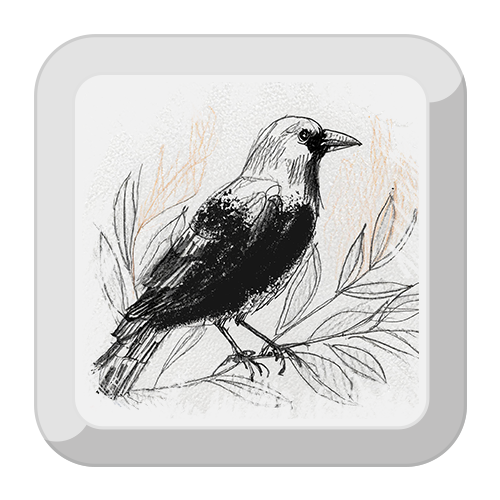0 Welcome to Birdcalls featuring the sounds of birds who make their homes here in Takoma Park. To hear a local bird press any key. That's a Northern Mockingbird recorded by Wilbur Hirschburger and provided to Birdcalls by the Macaulay Library at the Cornell Lab of Ornithology. To hear another bird, press any key.
1 That's a Northern Mockingbird, a virtuoso of imitation. Mockingbirds imitate other birds, cars trains and even alarms. Watch out during nesting season though, Mockingbirds are among the most protective parents in all of Montgomery County. They chase crows and dive at humans who get too close to their nests. Recorded by Wilbur Hirschburger and provided to Birdcalls by the Macaulay Library at the Cornell Lab of Ornithology.
2 Pileated woodpeckers, they drum on tree trunks to communicate. You can hear them cry out as they swoop from tree to tree in Takoma Park. Pileated woodpeckers have dramatic red crests on their heads. In mating season, a pair will find a nest site high up on a tree trunk. It can take a month to hollow it out. Recorded by Wilbur Hirschburger and provided to Birdcalls by the Macaulay Library at the Cornell Lab of Ornithology.
3 Those are a bunch of excited wood ducks. It was mating season. They once were hunted almost to extinction, but the wood duck bounced back. Their faces have a swirl of color so distinct they almost look fake. Recorded by Jeffrey Keller and provided to Birdcalls by the Macaulay Library at the Cornell Lab of Ornithology.
4 These are some crows, American crows. Some biologists say crows could be as smart as apes, but they are not picky eaters. Takoma Park crows eat seasonal fresh fruit and soggy French fries they find dumpster diving. Crows have to look out for hawks which raid their nests, so you'll sometimes see flocks of crows chasing a hawk around. Recorded by Bob McGuire and provided to Birdcalls by the Macaulay Library at the Cornell Lab or Ornithology.
5 You know the story, right? Once in Takoma Park, there lived a rooster named Rosco. He was an urban outlaw. Officers gave chase but they couldn’t catch the rooster. Rosco became a local hero, inspiring later generations of urban chickens here in Takoma Park. These clucking chickens and a big rooster named Saint Charles were raised and recorded by Sienna Chamino of Takoma Park.
6 Red-tailed hawks. These raptors ride a wind current and dive for prey in nearby Sligo Creek Park. Their call is used in television soundtracks to stand in for the sound of the bald eagle who’s cry is surprisingly meek. Recorded by Jeffrey Keller and provided to Birdcalls by the Macaulay Library at the Cornell Lab of Ornithology.
7 A pair of belted Kingfishers, They often cry out in flight then perch on a branch over a river bank. It can look like they're posing. The kingfisher has a big crest, a powerful bill and bold stripes. And from 30 feet up, they’ll plunge into the water to spear fish. Recorded by Jeffrey Keller and provided to Birdcalls by the Macaulay Library at the Cornell Lab of Ornithology.
8 This is Washington, D.C.’s official bird, not a bald eagle. It's a wood thrush. It was a favorite of artist John James Audubon not for how it looks but for how it sings. The wood thrush can be heard deep in the woods in springtime, singing variations on its watery song. If it sounds like two voices singing at once, that’s because the wood thrush actually has two voice boxes. Recorded by Wilbur Hirschburger and provided to Birdcalls by the Macaulay Library at the Cornell Lab of Ornithology.
9 Night herons on the water. There are two kinds black-crowned and yellow-crowned. Both grow extravagant plumes on their heads. Some night herons nest on branches above Sligo Creek. They're most active at night but if you're lucky you might see them in the spring cruising over the creek and broad daylight or wading in the shallows, spearing food to bring back to the nest. Recorded by Garrett Tin and Theodore A. Parker III, provided to Birdcalls by the Macaulay Library at the Cornell Lab of Ornithology.
* Birdcalls is a project created by David David Schulman, a violinist and audio maker, who lives in Takoma Park Howard Connolly of Howard Connolly Designs made the metal bird sculpture. This phone’s electronics were hacked and rebuilt by Brandon Hall of Autonomous Studios. This Birdcalls project is made possible by a public arts grant from the city of Takoma Park. The rooster was recorded on the first day of school here in Takoma Park by Sienna Chamino. All the other recordings of birds on this phone were provided by the Macaulay Library at the Cornell Lab of Ornithology. Look them up to learn more about local bird calls. The human voices heard on this phone belong to Felix Contreras, Vizanesh Culki, Tom Hizinger and me, Marika Partridge. For more, visit Birdcalls.us
# Hashtag? You’re thinking hashtag? Who needs Twitter when you can just tweet. That’s a Northern Cardinal (bird noises) Recorded by Bob McGuire and provided to Birdcalls by the Macaulay Library at the Cornell Lab of Ornithology.





















